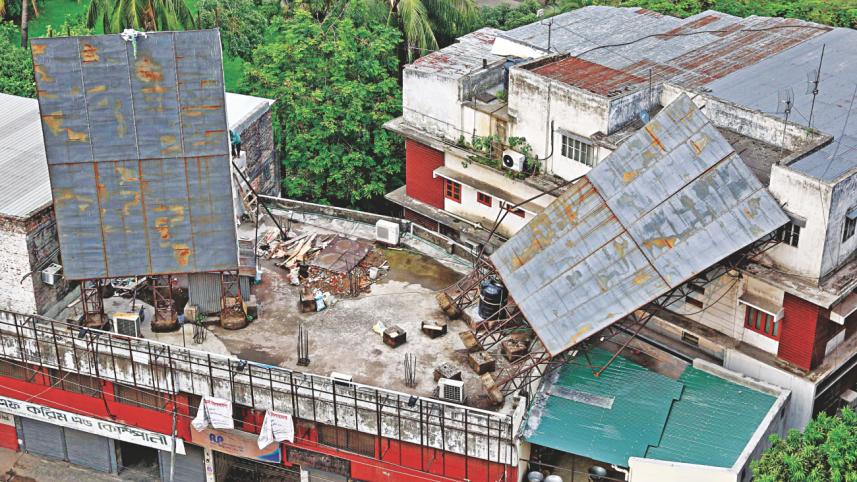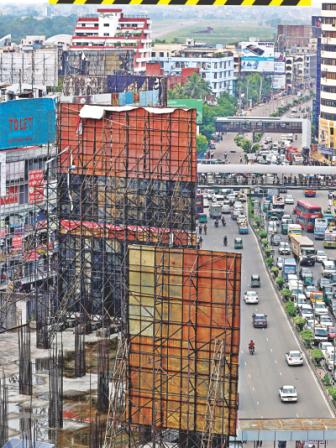Risky, illegal

Dhaka city people are exposed to serious risks of fatal accidents, particularly during storms, as the city authorities have failed to check the mushroom growth of billboards, many of them illegal and built without proper safety measures.
In fact, in the capital's two city corporations, illegal billboards outnumber the legal ones.
And although deaths from billboard collapse during nor'wester have become a common phenomenon in recent years, the city authorities remain unmoved, with a section of officials and ruling party men allegedly controlling the advertisement business.
Just on Saturday night, collapse of a colossal hoarding on several vehicles near Dhaka Club at Shahbagh during a nor'wester left the car of lawmaker Haji Salim, a police van, three minibuses and several rickshaws damaged. The MP, who was in the car, was unhurt but two rickshaw pullers were wounded.
In many cases officials of the two Dhaka city corporations and ruling Awami League men "authorise" illegal billboards for money, said sources in both the corporations.
Some city officials are even running advertisement businesses when it is their duty to check the abnormal growth.
"The authorities don't dare take action because of some officials and ruling party's involvement," an official said, requesting anonymity.
Exact numbers are not available, but sources say Dhaka South City Corporation has about 900 legal billboards against some 1,500 illegal ones (of which 527 are privately owned). In Dhaka North City Corporation, there are about 1,500 legal billboards against some 1,200 illegal ones.
Of those illegal in the DNCC, 257 were permitted by the Cantonment Board, 173 by the Air Force, 147 by the Bangladesh Railway, 10 by Dhaka Wasa and 22 by Bangladesh Police, while 443 are owned by private citizens, said a city official.
In recent years, such haphazardly erected billboards proved fatal. On March 15, 2010, two people died and eight others were injured when an 800 square feet hoarding sitting wobbly atop a shopping complex in Gulshan-1 collapsed. On April 20 the following year, a giant billboard collapsed near Dhanmondi Road-8 during a storm, though there was no casualty in the incident.
Contacted, Ansar Ali Khan, chief executive officer of DSCC, said they could not conduct drives in many cases for a lack of logistics, manpower and police force.
Many illegal billboards are set up at night, and even if the city officials carry out a drive, they can pull down at best three of them in a day.
Ansar added they were serious about the illegal billboards and would carry out drives to take those down.

Bipon Kumar Saha, chief waste management officer of DNCC, said they did not have logistics to conduct drives and needed to hire those whenever they went for a drive.
Another official in the north city said they published a notice in newspapers in February, giving 15 days' time for the illegal billboard owners to take permission from the city authorities by March 13.
"We have got applications from 18 firms for authorisation of 36 billboards so far," he said, adding that they would conduct drives against illegal billboards soon.
Under the law, prior permission of the city corporation is a must for setting up billboards. It is also mandatory for ad firms and private owners to collect no-objection certificates from authorised engineers as a proof of safety. But most companies and private owners violate the rules, said Bipon.
About the alleged involvement of some city officials in corruption, he said they would take action against them if found guilty.
Hoardings set up on high voltage electric cables may cause heavy casualties during powerful storms, said Md Rashed, general secretary of Outdoor Billboard Owners Association.
He also stressed that the city corporation engineers should keep vigilance so that no firms can set up risky billboards.
"Also, the authorities should not allow billboards here and there and thus ruin the city's beauty," he added.
In the past, the united Dhaka City Corporation used to follow some rules before giving permission for billboards. Back then there was a ban on setting up hoardings near 14 buildings and monuments, including Pantha Kunja, the National Museum and different hospitals. Also, billboards over electric cables were prohibited. But these rules are not followed now, officials said.
"The advertisement business is not in the hands of businessmen anymore. It is now controlled by the ruling party men. Most of them don't care for the law or safety measures," said a businessman, asking not to be named.




 For all latest news, follow The Daily Star's Google News channel.
For all latest news, follow The Daily Star's Google News channel.
Comments